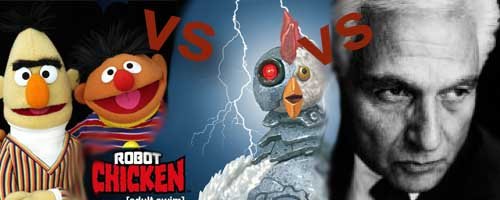
Whether the creators of Robot Chicken, Seth Green and Matthew Senreich, know it or not, their show is a fascinating demonstration of Jacques Derrida’s philosophical theory of deconstruction. For those that haven’t seen the show, and I can’t imagine why you wouldn’t have yet, Robot Chicken is a stop motion comedy sketch that reduces pop culture to its (ahem) finest elements.
Deconstruction
In short, deconstruction is a form of critical analysis that looks at the hidden meaning in both language and structure. In this short piece, I’m only dealing with what Derrida calls, “the center” from his lecture, Structure, Sign and Play in the Discourse of the Human Sciences (read it here!). To do a full examination of Robot Chicken and Sesame Street would take far more space. So, let’s get into it! The first video clip that we need to watch features Ernie and Bert from Sesame Street.
The Clips
After watching the clip, we can comment about the content quite easily. We might say things like: Ernie is asking questions. Bert gets annoyed over time (with good reason!). Or even, Ernie is pushing the boundaries of what Bert can endure in their friendship. Typically, however, we wouldn’t ask questions about the structure of the clip, the nature of Ernie and Bert’s relationship, or what happens when Ernie and Bert are off screen. According to Derrida, what is unspoken is as important as what is spoken. Enter Robot Chicken.
I don’t recall how it came about, but remember the claims that Ernie and Bert were gay? Maybe they are, maybe they aren’t but I like how Robot Chicken addresses the issue. But that’s kind of beside the point.
Ernie moving out and the introduction of Sam gives rise to new possibilities. Bert wants to change Sam into another Ernie, but Bert is kind of weak – even in the original. Remember how Bert always freaks out in the end? Here we see what happens when a stronger personality than Ernie is inflicted upon Bert. Also, keeping an Ernie and Bert sing-along is fantastic.
Center of Meaning
Derrida tells us that, “the center is inside and outside structure – center is at the center of totality but doesn’t belong to it.” Sesame Street was a show meant to teach kids anything ranging from the alphabet to being a good person. Ernie and Bert show us about the latter, particularly the nature of friendship. Growing up, I always enjoyed Ernie and Bert and took it at its intended meaning. Growing up and thinking back about the show, I always appreciated what Sesame Street did. Yet, you will notice that the center of meaning has already shifted. As a child, I enjoyed the program for what it showed me. As an adult, I appreciate how the show teaches children. It’s an obvious difference in the way that I enjoy the show.
Derrida goes on to tell us that there is a, “linked chain of determinations of center.” On the viewer’s level, this is the move from the meaning that we create as children, to the meaning that we create as adults looking back on ourselves and the show. Another link to the center of meaning is how a satirical cartoon meant for adults then links to Sesame Street. This is Robot Chicken’s role. The show takes a look at what elements are unspoken and pokes holes in it to create something new.
In a way, Robot Chicken is more like the old Ernie and Bert than in the newer episodes of Sesame Street. Ernie and Bert used to explore new areas of their relationship whereas now they seem to rehash old ideas. Meanwhile, Robot Chicken has given them the opportunity to, once again, explore. The outcome, of course, is significantly different – and hilarious.
The structure of the show is maintained by Robot chicken. Derrida tells us that the structure limits freeplay but is also what gives the possibility for it. Robot Chicken, working within the confines of the structure have created a number of substitutions and in this way becomes the new center, or is in the linked chain of determinations.
And this is why Derrida is so important today. Media is filled with this type of parody. Reworking old material, or poking fun at what exists is quickly becoming the definitive mark of the last decade and it owes its rise, in large part, to the work of philosophers like Jacques Derrida. As Derrida puts it, “decentering is the totality of an era.” Never before has this been as evident as it is today.
Dylan Callens is the author of Operation Cosmic Teapot, available at Amazon!





